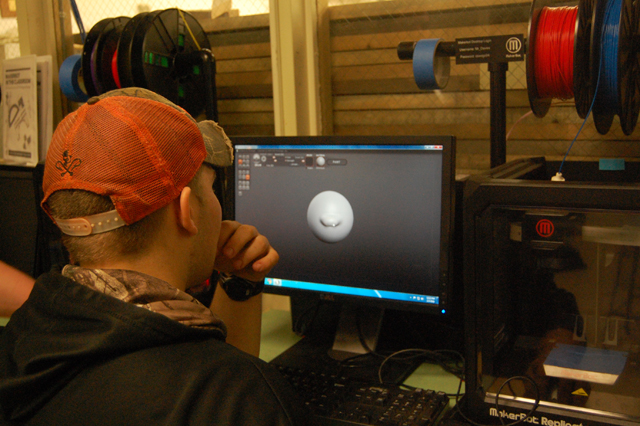Greenport High School’s 3-D printing lab growing into something special


Crowding the door of Mike Davies’ technology classroom at Greenport High School is a group of about 10 students eagerly watching a pancake being made.
But this isn’t your Aunt Jemima’s pancake. It’s not even being cooked in a pan.
Rather, this completely edible food item is being made using a 3-D printer, which allows students to make designs in it.
This is the first time any of these particular students have used the machine, called PancakeBot, and they’re clearly amazed. One flaw, they realize, is that the machine doesn’t come with a spatula. So Mr. Davies is printing one of those, too.
“It’s a lot of fun,” junior Tashan Lawrence said. “Especially when you get to eat.”
The 3-D technology lab began two years ago with just one printer used in the design and drafting for production class. Mr. Davies set out to purchase more, getting a deal that allowed him to buy eight printers for the price of four.
When school began this September, a new 3-D printing elective was on the schedule of 38 high school students. Additionally, Mr. Davies teaches 3-D printing classes for sixth and eighth graders.

As the year goes on, the teacher continues to expand the lab. It has grown to over 20 machines — such as different sized 3-D printers, laser cutters, a desktop scanner and machines that cut shapes and letters into wood — as well as dozens of spools of plastic filament through nearly $80,000 worth of donated items he secured through networking and social media use. The district has paid less than $5,000 for the equipment.
Depending on where the printer is coming from it is either shipped to the school or Mr. Davies picks it up himself. The newest addition to the lab is currently being shipped from California. Last weekend, Mr. Davies packed up his truck and drove to Boston for a printer.
“I wanted to hit all areas,” Mr. Davies said of the machines he’s been adding to the lab. “We have people who are contacting us … who want to come in and talk to my kids. It’s a viable thing, we’re not just messing around making stuff.”
Some of the donated printers come broken, so Mr. Davies has advanced students in his high school classes work on fixing the machines and making them usable again. This requires rewiring buttons, having construction students build stands and using working 3-D printers to make missing parts.
“What I really wanted the laser cutter for is gaskets, because we buy so many things,” Mr. Davies said. “They lose stuff and every time you do that it eats up the budget … we’re able to make them quicker than it is to buy them and cheaper because it’s basically free.”
The students are very involved in the class, like getting to design their own projects, which is something they said they enjoy.
“I like that there’s always something to learn about it,” senior Isabel Wachtel said. “There are no limits to learning how to print and what to print.”
Mr. Davies started the classes out by using one of the five “beginner training” printers, called MakerBot replicator minis, to teach students troubleshooting and easy ways to print so the kids got used to the products.

Students can use a website called Thingiverse to find pre-made designs for items they want to make, such as useful ideas like phone cases, gas caps, prosthetic hands and ice scrapers or fun items such as key chains, Yoda replicas or animal skulls. Additionally, there are programs that allow the students to make original designs, some which were used as fossils for an elementary school project.
After downloading the image and information off Thingiverse students are able to create the item using the machines. The items are made in layers of PLA filament, a thermoplastic that is soft and moldable when heated and solid when cooled. Depending on the size of the item it can take anywhere from 20 minutes to a few hours to complete.
Once students get the hang of printing they can move on to other machines, such as the laser cutters or larger 3-D printers.
Use of the printers also extends to students outside of the 3-D printing classes. Currently, students in teacher Lisa Baglivi’s crafts class are using the printers after school to make projects for Peconic Landing’s memory garden.
Ms. Baglivi said students spend class time designing either an individual or group piece — which include hearts, birds and a ferris wheel — and then visit the lab after school to print out scale models of their ideas.
“I find that I’m old school in many ways, but I love that they can make the connection and I think that the kids today love technology,” she said. “I think they really enjoy it.”
Mr. Davies’ students enjoy the class so much they spend their free periods checking out his technology lab and making quick projects. Some of these students aren’t in the crafts or 3-D printing classes, but are interested in using the machines.
“We have some kids that do come after school to learn,” Mr. Davies said. “If they want to and if the printers free … as long as they’re not roughhousing in here and getting wild, its fine.”
TOP PHOTO: Teacher Mike Davies demonstrates the software used in 3-D printing. (Credit: Nicole Smith)








